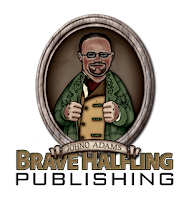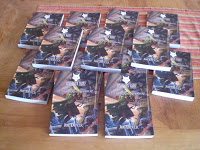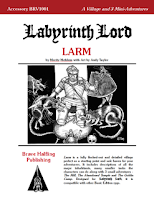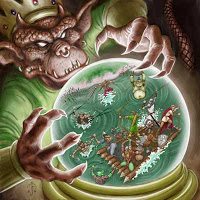Part 2 – Religion, Pathfinder, 4E and all the Rest…
9. I know that you’re interested in the history of Christianity. Have these roots ever played a role in games or settings you have designed in the past?
– One’s ethos always influences one’s work, whether one is supporting them or working against them. I would self-identify as Christian, and if pressed would list my religion as “suburban Presbyterian” – one of those sub-branches of Protestantism that believes you will be admitted to the kingdom of heaven if you bring a covered dish to pass.
– But more to the point – the gods of Dragonlance come out of my personal campaign. They in turn, were named in part after figures and words from the Bible. Gilean the book was originally Gilead (as in no balm in Gilead). So Mishakal descended from the flaming hand that wrote, and having written moved on.
– Here’s another one, from Al-Qadim – the three types of Cleric kit had Protestant origins. Moralist, Ethoist, and Pragmatist translate as Baptist, Presbyterian/Methodist and Unitarian. It allowed me to have one Pantheon (as close to monotheism as we would get) while providing three divergent views of it.
10. Which changes did the change from TSR to WotC bring for you personally?
– It got me to Seattle. More seriously, I had left TSR by the time the worst of the financial troubles had hit, but remained close to the rest of the staff (I was still living in Lake Geneva). After TSR moved out to Seattle, it got kind of lonely in the area, so a reapplied to work at WotC and Bill Slavicsek (With Peter Adkison’s approval) brought me out, for which I remain eternally grateful.
11. What can you tell me about your work with Sovereign Press?
– Margaret Weis is one of the hardest-working writers and nicest persons in the business, and has always been extremely supportive of other writers and creatives. When I was freelance, I worked for one of Margaret’s earlier companies – MagForce 7.
– My contribution for to Sovereign Press was primarily supportive in nature – rulesbashing, concepting, and early playtesting. Larry Elmore and I spent a convention talking about his idea for an original fantasy world that became Sovereign Stone (a conversation that ended in a car accident, by the way). We had playtested the original SS rules with barfights (in which we created the idea of the “Flaming Lembek”). I was more support staff and sounding board than leading creative, but remain delighted to see how things turned out.
12. Which parts of the Pathfinder Campaign Setting have you worked on? How can you describe the collaboration with the guys at Paizo?
– My contributions to Pathfinder have been small things – the Linnorm Kings, Mammoth Lords, and the Chelliax in the Pathfinder Campaign Setting, and an article on the Drow for a recent series. My sense of humor can be found in my description of Chellaxian opera. Yep, I’m the one you blame for that.
– Collaboration is Fun. The Paizo team have definite ideas of what they want in each part of the process, but are very accommodating to new ideas and concepts. This is their world, and they want to make sure that everything fits.
13. Can we hope for a Jeff Grubb Pathfinder module, an Adventure Path or other contributions o the Pathfinder universe?
– Anything in the future would be short. We had been discussing a longer project, but I had to drop out because of other conflicts. My fault, not theirs.
14. In your career you have worked on various settings like Spelljammer, Mystara, Al-Qadim, Dragonlance… Can you compare those to Golarion? Are there differences, similarities…?
– Actually of all the worlds, Golarion reminds me most of the Realms, in that it is a broad tapestry that supports and interlocks many different game and cultural styles. While the Realms evolved into its present state (which is why Ed ended up with a number of Arabian-style cultures in the campaign, as his work kept expanding), Golarion shows a lot more planning and thought about larger arcs and storylines
15. What do you think of the newest incarnation of the world’s most popular RPG, D&D 4E?
– I was a playtester on 4E, and my regular Thursday night group is made up of WotC Illuminati. I like the new system, and see a lot of parts that are more elegant and engaging.
– Now, I also like the previous editions as well. I see game design as a conversation, the evolution of the design as a continuing of that conversation. 4E does not exist in a vacuum, but rather has grown up in a very different world than previous editions. The original game shows its miniatures game roots, the 2nd edition was heavily influenced by an expanding bookstore market, and the 4th edition shows influence from miniatures, card games, and computer games.
16. What do you think? How will D&D and Pathfinder evolve?
– D&D will stress more roleplaying in the future. I think part of the concern about the heavy mechanics of 4E is in part because there were a lot of new rules, in particular rules that were based on different assumptions than previous editions. That’s a lot of data to throw into the buffer all at once. As people come to terms with the new concepts and start modifying them on their own, we will see more space free up for roleplaying.
– Pathfinder? I can’t tell you, since I haven’t gotten a copy of the new rules yet. Hey, I’ve been busy.
17. If WotC did new versions of Al-Qadim and Spelljammer would you be willing to contribute?
– I would be flattered to be asked, but I’ve pretty much said what I have to say on those subjects the first time around. I did a short adventure for Open Design’s Six Arabian Nights, and could be convinced to do another, but I laid out “my” dream Arabian Campaign, and I am pleased with the result. I’d rather see what other people do with it.
– For example, Andy Collins did a revision of Spelljammer for d20 – Shadow of the Spider Moon, which I thought was very nice, taking the cool stuff from SJ and putting it into 3E.
18. Have you heard of the clone games like OSRIC, Labyrinth Lord or Swords & Wizardry? Why do people return to the stone age of role playing games?
– You never forget your first love. You always remember your first cleric, your first 10 by 10 room, your first TPK. I still get all nostalgic about the original three little books in their wood-grained box, though I know we had to do a lot of house-rulings at the time.
– A lot of people got into D&D in the late seventies, when the game consisted of the AD&D Monster Manual and the officially unconnected but still-used D&D Red Box. I think that’s part of it the attraction to this “golden age”.
– But another part is a desire for a simpler system, and the early D&D was simpler (it also didn’t cover a lot of stuff that l
ater editions covered). Looking back, a lot of early RPG design in late seventies was “How I would fix D&D”. I think the Old School Renaissance goes back to those roots. The good old days, but better.
19. Do you know the fanzine “Fight on!”?
– Have heard of it, but haven’t read it. It just showed up on my radar when someone mentioned it covered Empire of the Petal Throne, which is one of the GREAT early RPGs.
20. Over here in Germany we have never heard of the “Alliterates”. Please tell me more of this group of people?
– The Alliterates are a writers’ group, originally based in Lake Geneva and founded by editor and author J. Robert King. It was originally founded as a reason for writers to get together, drink, smoke cigars, talk about writing, and complain about their editors. Several of the current members are ex-smokers, so we don’t do cigars anymore.
– All of the original members were a) local, and b) current or former members of TSR, and had work published by TSR, so we all come from the same general shared-world background. That’s no longer as true as it once was, but the majority of us all have “TSR/WotC stories”.
– The original group still meets near Lake Geneva, and though the bar they meet in has moved, the new space has kept sufficient room so they can meet. A number of us expats ended up in Seattle, and Dave Gross put together the West Coast version of the team (before taking off for Canada). So both groups meet once a month.
– The Alliterates Website is here – http://alliterates.com/ – and our alumni include Rob, Dave, Star Wars Author Troy Denning, Guild Wars author Matt Forbeck, Cartoonist Stan! Brown, Editor Wolfgang Baur, and horror writer Lorelei Shannon.
21. Your blog http://grubbstreet.blogspot.com/ is the “Methhusalem of blogging” – is there a recipe for success – as most blogs wither away after only weeks or months?
– I kept a journal for many years, so I use the blog as a warm-up for writing. It also allows me to get things out of my mind so I can go onto more important matters. I rarely talk about what I’m working on, or drop any secrets, or grouse about co-workers or employers (you have to buy me a beer for that and turn off all electronic devices).
– I also blog because it saves my Lovely Bride the pain of listening to me tell the same story over and over again.
– I think of blogging as totally for me. I don’t track numbers, and don’t even know if there IS a anyone out there reading. It is very low-key, and skitters all over the joint. I have a lot of interests just beyond my day job, and this indulges them.
22. Are you still working in the RPG industry or have you moved to computer game design like many of your former colleagues like Lawrence Schick or others?
– My day job is working for ArenaNet on the upcoming Guild Wars 2 project. My official title is Game Designer, but my responsibilities including world-building, continuity, and cinematic scripts. This is the current “big thing” in my life.
– I also do a lot of small things – the occasional short story, essay, or game article. I work with Wolfgang Baur at Kobold Quarterly as a consulting editor. Given the nature of day job, I find that it is easier to do small things than larger project.
– Have said that, I am working on a novel at the moment, title yet to be determined. Stay tuned.
THANKS, JEFF!!!
 Es wurde schon lange gefordert – jetzt sind die ersten Teile der Delving Deeper-Serie von BHP auch endlich in Print-Fassung erhältlich.
Es wurde schon lange gefordert – jetzt sind die ersten Teile der Delving Deeper-Serie von BHP auch endlich in Print-Fassung erhältlich.








